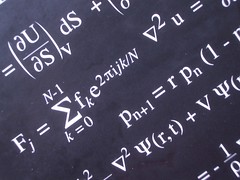 |
In collaboration with K. Grabowska and J. Grabowski, we have examined the finite versions of weighted algebroids which we christened ‘weighted Lie groupoids’. |
Groupoids capture the notion of a symmetry that cannot be captured by groups alone. Very loosely, a groupoid is a group for which you cannot compose all the elements, a given element can only be composed with certain others. In a group you can compose everything.
Groups in the category of smooth manifolds are known as Lie groups and similarly groupoids in the category of smooth manifolds are Lie groupoids.
It is well-known every Lie groupoid can be ‘differentiated’ to obtain a Lie algebroid, in complete analogy with the Lie groups and Lie algebras. The ‘integration’ is a little more complicated and not all Lie algebroids can be globally integrated to a Lie groupoid. Recall that for Lie algebroids we can always integrate them to a Lie group.
Previously we defined the notion of a weighted Lie algebroids (and applied this to mechanics) as a Lie algebroid with a compatible grading. A little more technically we have Lie algebroids in the category of graded bundles. The question of what such things integrate to is addressed in our latest paper [1].
Lie groupoids in the category of graded bundles
The question we looked at was not quite the integration of weighted Lie algebroids as Lie algebroids, but rather what extra structure do the associated Lie groupoids inherit?
We show that a very natural definition of a weighted Lie groupoid follows as a Lie groupoid with a compatible homogeneity structure, that is a smooth action of the multiplicative monoid of reals. Via the work of Grabowski and Rotkiewicz [2] we know that any homogeneity structure leads to a N-gradation of the manifold in question; and so what they call a graded bundle.
The only question was what should this compatibility condition between the groupoid structure and the homogeneity structure be? It turns out that, rather naturally, that the condition is that the action of the homogeneity structure for a given real number be a morphism of Lie groupoids. Thus, we can think of a weighted Lie groupoid as a Lie groupoid in the category of graded bundles.
I will remark that weighted Lie groupoids are a nice higher order generalisation of VB-groupoids, which are Lie groupoids in the category of vector bundles. These objects have been the subject of recent papers exploring the Lie theory and application to the theory of Lie groupoid representations. I direct the interested reader to the references listed in the preprint for details.
Some further structures
Following our intuition here that weighted versions of our favourite geometric objects are just those objects with a compatible homogeneity structure in [1] we also studied weighted Poisson-Lie groupoids, weighted Lie bi-algebras and weighted Courant algebroids. The classical theory here seems to be pushed through to the weighted case with relative ease.
Contact and Jacobi groupoids
The notion of a weighted symplectic groupoid is clear: it is just a weighted Poisson groupoid with an invertible Poisson, thus symplectic, structure. By replacing the homogeneity structure, i.e. an action of the monoid of multiplicative reals, with a smooth action of its subgroup of real numbers without zero one obtains a principal $latex\mathbb{R}^{\times}$-bundle in the category of symplectic (in general Poisson) groupoids. Following the ideas of [3] this will give us the ‘proper’ definition of a contact (Jacobi) groupoid. We will shortly be presenting details of this, so watch this space.
References
[1] Andrew James Bruce, Katarzyna Grabowska, Janusz Grabowski, Graded bundles in the category of Lie groupoids, arXiv:1502.06092
[2] Janusz Grabowski and Mikołaj Rotkiewicz, Graded bundles and homogeneity structures, J. Geom. Phys. 62 (2012), no. 1, 21–36
[3] Janusz Grabowski, Graded contact manifolds and contact Courant algebroids, J. Geom. Phys. 68 (2013), 27–58.
